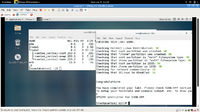Difference between revisions of "Lab 5 Warnings / Debrief"
(Created page with '= Preparing for Lab 5= == Purpose of Lab 5 == == Common Mistakes / Warnings == {{Admon/important |Be Aware of the Following Issues| Be aware of these common mistakes that st…') |
|||
| Line 1: | Line 1: | ||
| − | = | + | = Purpose of Lab 5 = |
| + | |||
| + | == What is LVM? == | ||
| + | |||
| + | Monitoring and ensuring adequate space for a Linux file-system is considered to be a critical task for any system administrator. An application called '''LVM''' is a very useful tool for Linux system administrators to easily manage file systems - even when the computer system is running! | ||
| + | |||
| + | '''LVM''' ('''Logical Volume Management''') is used to manage hard disk drives / partitions for Linux and Unix systems. LVM provides more flexibility than just partitioning hard disks. '''Volume Groups''' are areas used to define '''Physical Volumes''' (i.e. hard disks, disk partitions, or other forms of storage devices). '''Logical Volumes''' are then used to relate directories (mount points) to a specific physical volume or for a "range" or "span" of physical volumes. | ||
| + | |||
| + | LVM allows more flexibility and growth potential for Linux systems (for example, having Logical volumes span multiple hard disks). CentOS uses LVM by default upon installation. Other Linux distributions may provide the capacity to install LVM, | ||
| + | |||
| + | == Any Simple Comparisons for LVM !?! == | ||
| + | |||
| + | '''Certainly...''' | ||
| + | |||
| + | [[Image:lab1_signoff.png|thumb|right|200px|Students should be prepared with a'''ll required commands (system information) displayed in a terminal (or multiple terminals) prior to calling the instructor for signoff'''.]] | ||
| + | |||
| + | |||
| + | Think of adding space like building a cake: | ||
| + | |||
| + | * A cake needs to rest on a platter. | ||
| + | * In our case the platter is known as the volume group. In this way we can support different volumes groups for different purposes (eg. accounting dept, IT, management, etc) just like different platters would hold different types of cakes for the party! | ||
| + | * Just one thing: We can grow our space between other partitions in various volume groups (or platters). | ||
| + | |||
| + | |||
| + | |||
| + | |||
| + | |||
| + | |||
| + | |||
| + | |||
| + | |||
| − | |||
Revision as of 14:28, 7 July 2015
Contents
Purpose of Lab 5
What is LVM?
Monitoring and ensuring adequate space for a Linux file-system is considered to be a critical task for any system administrator. An application called LVM is a very useful tool for Linux system administrators to easily manage file systems - even when the computer system is running!
LVM (Logical Volume Management) is used to manage hard disk drives / partitions for Linux and Unix systems. LVM provides more flexibility than just partitioning hard disks. Volume Groups are areas used to define Physical Volumes (i.e. hard disks, disk partitions, or other forms of storage devices). Logical Volumes are then used to relate directories (mount points) to a specific physical volume or for a "range" or "span" of physical volumes.
LVM allows more flexibility and growth potential for Linux systems (for example, having Logical volumes span multiple hard disks). CentOS uses LVM by default upon installation. Other Linux distributions may provide the capacity to install LVM,
Any Simple Comparisons for LVM !?!
Certainly...
Think of adding space like building a cake:
- A cake needs to rest on a platter.
- In our case the platter is known as the volume group. In this way we can support different volumes groups for different purposes (eg. accounting dept, IT, management, etc) just like different platters would hold different types of cakes for the party!
- Just one thing: We can grow our space between other partitions in various volume groups (or platters).
Common Mistakes / Warnings
Preparing for Lab Sign-Off
In order to properly complete your lab and move to the next lab, you must have your instructor "sign-off" on your lab
- Each "signed-off" lab (before due date) is worth 1% of your final grade.
- Signing-off on labs help to spot errors that can cause problems with future labs.
- Do you ask the instructor what to check for! Read at the bottom of the lab the requirements, and have all proof available for instructor to view at same time.
- Failing to be prepared and asking instructor what to check when assignment is mark will result in deduct of marks!
- For example, open multiple terminals with command results. If properly set-up ahead of sign-off, the process should only take instructor approx 20 seconds to sign-off your lab.
- If you do not have your lab-logbook, you MUST show your work and your lab log-book to your instructor for sign-off in the next class. This may cause a late penalty if past the required due date.
